Intermarkets' Privacy Policy
Donate to Ace of Spades HQ!
aceofspadeshq at gee mail.com
Buck:
buck.throckmorton at protonmail.com
CBD:
cbd at cutjibnewsletter.com
joe mannix:
mannix2024 at proton.me
MisHum:
petmorons at gee mail.com
J.J. Sefton:
sefton at cutjibnewsletter.com
Plus: More Quick Hits
Quick Hits
Mortgate Rates Fall to Lowest Level In Three Years As CNN Grieves
Trump Again Warns Walz and Frey: Start Enforcing the Law, Or Federal Troops Are Coming
For Some Reason AP and ABC "News" Cannot Even Guess At, Overdose Deaths In the US Plummeted in 2025
Thwarted True Venezuelan President Presents Her Nobel Peace Prize to Trump
As SCOTUS Debates "Trans Women" Competing in Girls Sports, the World's 671st Ranked Male Tennis Player Easily Beats the Woman Ranked #1; also, Remembering Scott Adams and Dilbert
Mid-Morning Art Thread
The Morning Report — 1/16/26
Daily Tech News 16 January 2026
Jim Sunk New Dawn 2025
Jewells45 2025
Bandersnatch 2024
GnuBreed 2024
Captain Hate 2023
moon_over_vermont 2023
westminsterdogshow 2023
Ann Wilson(Empire1) 2022
Dave In Texas 2022
Jesse in D.C. 2022
OregonMuse 2022
redc1c4 2021
Tami 2021
Chavez the Hugo 2020
Ibguy 2020
Rickl 2019
Joffen 2014
maildrop62 at proton dot me
TBD
Saturday Gardening Thread: Baby, It's Cold Outside [Y-not and KT]
Y-not: Good afternoon, gardening morons and moronettes! Cold enough for you yet?
This. Is. Awesome.
(Performance from Neptune's Daughter. Speaking of Ricardo Montalban, does anyone remember him in Battleground? That was a classic WWII flick.)
Actually, I lie. It's quite mild in Kentucky right now. We're expecting it to hit 70 today. Obviously, I credit Global Warming.
Despite the warm weather throughout much of the country, Christmas is nearly here... which can only mean one thing: Christmas trees (and holly... as we'll see from KT).
Here's a Christmas tree, Kentucky style:

I spotted the bourbon barrel tree while on a short visit to Lexington (Kentucky, NOT Massachusetts). It's located in Cheapside Park, not far from the convention center. Cheapside has an interesting history. A short distance from today's park there's an historical marker:
Historical Marker #2122 in Lexington notes the location of the Cheapside slave auction block.During the antebellum years, Lexington was the capital of Kentucky's slave trade. Because of the city's location in the heart of the bluegrass region, where slaves were most prevalent, traders found a good market for sales. In addition, as Lexington was in the middle of the state and far from the Ohio River, it was difficult for slaves to escape. Therefore, Lexington became the focal point for the slave exchange with Cheapside Auction Block as the town's primary location for trading slaves.
Anyhoo, back to Christmas trees...
Last year we covered traditional Christmas trees and learned that firs are the type most-favored by the horde. This year, inspired by that bourbon-barrel tree, I thought we could look at some unusual Christmas trees.
A brewery in New York constructed one out of kegs:
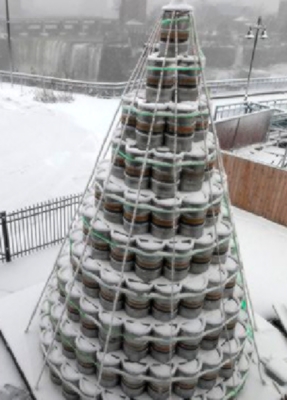
In Melbourne, someone made one out of flip-flops:
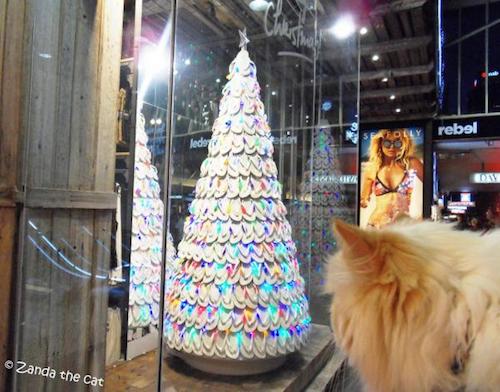
A friend of mine tells me she's seen a similar one in the Cayman Islands.
Here are some more neat ideas for making or decorating a Christmas tree.
My cats would have a field day with this "floating" tree:

Predicted "life span": about three minutes.
Here's a neat one:
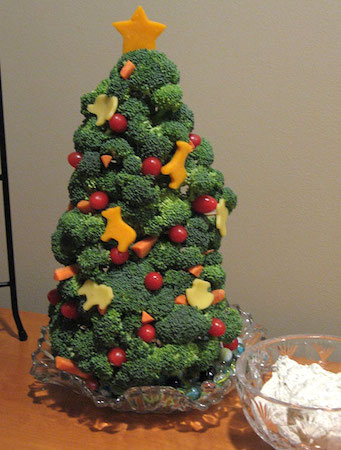
President Bush doesn't like it, though.
What cool Christmas trees have you seen?
**UPDATED: I just had to include NDH's "ugly trees" picture:
I rearranged a couple of the ornaments. I'd say it's a big improvement. #UglyTree2015 pic.twitter.com/QR4kI2EFLi
— Nied's Dead Horse (@mflynny) December 10, 2015Or just go traditional.
MORE CHRISTMAS TRADITIONS
Last week we shared some of our hometowns' Christmas traditions. This is not gardening-related, but a couple of days ago I learned that in parts of Kentucky there's a tradition of celebrating "Old Christmas":
Old Christmas is still a remembered tradition here in Eastern Kentucky. I don't know many other places where that is so, but here traditions are slow to die. When Dean was growing up, they received presents on Old Christmas as well as December 25th -- not as many, but otherwise just like Christmas. Furthermore, Christmas and Old Christmas each had their own traditions.Modern Christmas in this area was not so much a religious holiday as a festivity: it was was more closely associated with alcohol than with religion. In fact, Christmas was a real boon for moonshiners, because businesses bought moonshine and passed it out to employees. On Christmas Day, the men in the house drank moonshine all day long, and expected every visitor (or at least every male visitor) to partake. Then and now, everybody shot off guns to mark the occasion. Dean says that along Mill Branch, where his grandparents lived, gun shots echoed all day long on Christmas.
One of the big Christmas traditions was to make carbide cannons, which made wonderful and very loud fireworks. Dean remembers walking past one house that had shot off so many carbide cannons that the valley was filled with smoke. You don't see carbide cannons anymore, at least to my knowledge, but I suspect the fading of that custom has more to do with the advance in underground mining technology than with anything else. In the old days, miners had carbide lights in their hardhats, so carbide was readily available. Today it is not.
Old Christmas is on January 6th. You might know it as the Feast of Epiphany.
Do any of you celebrate "Old Christmas?"
Speaking of Kentucky, we are part of Japan's Christmas celebrations. Here's why.
CHRISTMAS IS FOR THE BIRDS
A couple of weeks ago co-blogger and all-around-great-guy The Dude (aka @WoodWhisperers on Twitter) suggested we cover some backyard birding during these long winter months. We've done a little bit of this in the past here and here and here, but I love birds so I'm happy to include more bird-related content.
Here are some ideas for making a bird-friendly Christmas tree. A few more here.
BIRD-FRIENDLY TREES AND SHRUBS
I love backyard birds and enjoy learning about the bird population wherever we happen to be living. I've "lost" the striking Western Jay, but (re)gained Cardinals. Fair trade, imho.
If you're like me, you might want to try to attract birds to your backyard. Here are some ideas from All About Birds and Birds and Blooms.
I'd like to plant some fruit-bearing trees and shrubs, but Mr Y-not is hesitant because the potential mess they might make. That's certainly a consideration, but I'm hoping if we planted them near the edges of our yard, that wouldn't be such a problem.
On a related note, we have several large cedars (I think they're Eastern cedars) near out back fence line. At dusk they become a favorite roosting location for hundreds of starlings:

Boy, am I glad the cedars aren't near our house. Starlings are quite vocal!
It's fascinating to watch the starling "murmurations." The flocks form amazing patterns and the noise their wings make can be quite startling when they swoop down low.
If you've never witnessed this phenomenon before, here's a video:
Which plants in your yards attract winter birds?
Now, here's KT:
Hello, Horde. We had a little rain this week in the Central Valley, with snow in the mountains. Yay! There is still pretty fall foliage on some trees. The weather has been mild. Anything going on in your neck of the woods?
Tis the season to see holly
I thought that holly would be a fitting subject as we look forward to Christmas. One person who may occasionally deal professionally with roots from holly trees is very careful about the subject of a holly, jolly Christmas. Heh.
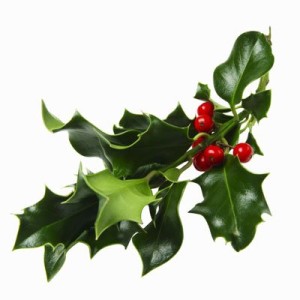
There is a lot of mythology and folklore attached to hollies, much of it related to Christmas. But did you know that holly trees were once thought to protect against lightning strikes? There is a reference to holly in Shakespeare, in As You Like It, Amiens, philosophizing on ingratitude and insincere friendship:
Heigh-ho! sing, heigh-ho! unto the green holly: Most friendship is feigning, most loving mere folly: Then, heigh-ho, the holly! This life is most jolly.
The curator of the Scott Arboretum at Swathmore College in Pennsylvania writes in Fine Gardening:
The mere mention of holly brings to mind conical trees with spiny leaves and red berries in winter. That image is valid, but I love evergreen hollies because they are, in fact, so much more diverse than that. They range in size from a 6-inch-tall spreading dwarf to a 70-foot-tall towering giant. Leaves may be small and spineless or large and armed. Berries can be red, orange, yellow, or black. Hollies are one of the few genera that can be grown in all 50 states.He concentrates on evergreen hollies. "The Ilex genus contains more than 780 evergreen and 30 deciduous species of trees and shrubs native to North and South America, Europe, Asia, Africa, and Australia." Check out the slideshow of hollies for specimen plants, combining good foliage and great berries. He offers tips on use of hollies both as specimens and in foundation plantings.
Several hollies are naturals for hedges, screens and privacy barriers. Pruning tips are offered for these uses of holly. "The Scott Arboretum was designated an official Holly Arboretum by the Holly Society of America. Each year, we evaluate every specimen in our collection for aesthetics, winter damage, and pest and disease problems. After 15 years of evaluation, hollies appear to be relatively trouble free in Philadelphia's USDA Hardiness Zone 6 climate."
The Holly Society of America offers a photo gallery and links for information concerning planting, pests, holiday lore and more. From the University of Vermont Extension: ". . . did you know that "decking the halls with holly" is an ancient custom several thousand years old? The ancient Romans, Greeks, and Druids all decorated their homes with this plant. . . "
ENGLISH HOLLIES
English holly is grown commercially in the Northwest, where it has escaped cultivation to become invasive in some areas.
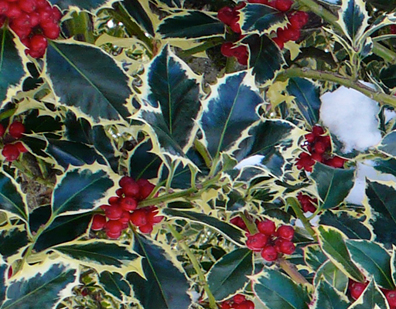
English holly grows best in areas with relatively mild winters and relatively humid air. Like most hollies, it does best in acid soil. In the West, it is recommended for parts of the Northwest, the San Francisco Bay area and Hawaii above 4,000 feet. My Sunset Western Garden Book lists 24 varieties of English holly, both male and female, with smooth or spiny leaves. There are many others. "Balkans" (from the Balkans) is the most hardy. It comes in male and female forms. Variegated English hollies come with silver edges, silver centers or gold edges. "Silver Queen" and "Golden Queen" are both male cultivars. They were named long before Bruce Jenner . . .
There is also a particularly dense male holly with twisted, fiercely spiny leaves and sterile pollen, known as the ferox, hedgehog or porcupine holly. Recommended for hedges and barriers. It comes in both green and variegated forms.

BLUE HOLLIES
Blue hollies (Ilex meserveae) were bred to extend the traditional look of English hollies further north. Most are hybrids between English holly and a cold-hardy Japanese holly. Female forms with berries are generally sold with a male counterpart for pollination. Blue Girl and Blue Boy in the same container are marketed as Berri magic. Be careful that the male plant does not outgrow the female plant. If you have a female holly with no male partner, you can graft a male branch onto it. Landscaping tips here.
Where winter winds are cold and dry, you may want to treat Blue Hollies and other broad-leafed evergreens with a plant anti-transpirant, which can also slow the drying of Christmas trees and non-fuzzy plant leaves on indoor decorations. Good to have on hand for transplanting bare root trees which have leafed out, too. You can buy anti-transpirant concentrates, generally made from a polymer diluted in water, using the Amazon thingy at AoSHQ.

Blue hollies came into being from the breeding work of Mrs. F. Leighton Meserve. China Girl and China Boy were developed a few years later. They are hybrids of Chinese Holly and the cold-tolerant Japanese holly mentioned above. They are a little hardier than other blue hollies, and more tolerant to summer heat. I denounce myself for mentioning their names.
NATIVE HOLLIES
My theme for today was actually stolen from a garden blogger who wrote about native hollies she saw while traveling in Louisiana. These included the deciduous Possumhaw, its evergreen cousin the Youpon holly and the more familiar American holly.
She worries that with wild stands of Possumhaw being removed, people planting female cultivars will no longer get berries on their bushes or trees. But Southern Living notes that there is a male pollinator, Red Escort. You can also use a male American or Yaupon holly as a pollinator.
The other native deciduous holly planted in gardens is Winterberry or Christmasberry. Both the Possumhaw and Winterberry are great for attracting songbirds. They are also useful in winter floral arrangements. The Possumhaw can grow bigger, to 25 feet. It is somewhat tolerant of rocky, alkaline or limey soil. The Winterberry is tolerant of wet, boggy soil.
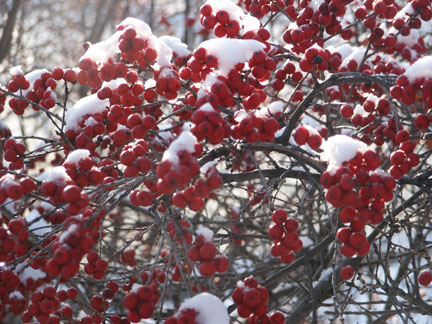
Sunset notes that the Winterberry is hardy into Alaska. Their recommended cultivars include Afterglow, Winter Gold, Cacapon, Fairfax, Sunset and Winter Red. Red Sprite is a dwarf with large berries. Pollinators include Dwarf Male, Jim Dandy, Late Male and Southern Gentleman.
There is a hybrid of the Winterberry and a Japanese species called Sparkleberry Holly. Sunset notes that it is almost as hardy as Winterberry. "The hybrid is more than the sum of its parts. Once its simple leaves turn gold and drop, the shrub is a handsome tangle of gray bark blinged with big, red berries. The birds get to them eventually, but the berries should last through the winter." Cultivar recommendations at the link.
American holly grows into a pyramidal or round-headed tree, generally seen from 15 to 30 feet tall. It grows slowly into a larger tree. It is cultivated commercially in the Southeast for use in holiday decorations. It is now illegal in many states to collect it from the wild. American Holly can be grown in many western regions and is resistant to oak root fungus. Some cultivars are hardy into parts of New England. If you are interested in recommended cultivars for various regions, let me know in the comments.
Yaupon (Ilex vomitoria) is the native holly most tolerant of very alkaline soils. Sunset recommends it for most western zones, but not for the desert. It is the North American counterpart of the South American holly Yerba Mate, which Che Guevara so charmingly sucked from his gourd. Tea made from its leaves was popular with American colonists until about the time that coffee became popular. Yaupon contains more caffeine than any other North American plant. Celebrate the heritage of early America this season with some Brown Butter Maple Nutmeg Cookies and a cup of Yaupon Tea or caffeine-free American Holly tea.

The Eat the Weeds Guy has a fascinating, detailed Colonial and Native American history woven into his more practical information about Yaupon Holly. It was used as an everyday tea among southeastern tribes and colonists. Its scientific name comes from its use in a much stronger male-only ritual drink which induced vomiting. Status of the drinkers rose if they could keep the stuff down longer than their friends.
He also discusses other hollies that can be made into tea for either caffeine, antioxidant content or sometimes both. "The American Holly was a popular tea during the American Civil War. Interestingly, the American Holly and the English Holly were used to clean chimneys because of their stiff, toothy leaves." He reminds us that many (not all) holly berries are toxic. "You are not a woodland creature, so leave them alone."
His video on tea hollies includes identification and landscaping tips.
Yaupon hollies are excellent for training, shearing and topiaries. The cultivar with the most caffeine is Ilex vomitoria pendula, which he shows trained as a standard, then sheared in the form of an upside-down bowl, apparently a classic form for this plant. Other cultivars include "Nana" and "Stokes", female and male dwarfs, respectively, used like Japanese boxwood. "Will Fleming" is a tall, columnar male and "Pride of Houston" is a female shrub with profuse berry production.
The last commercial use of Yaupon Tea appears to have been in the Carolinas. "When it came to drinking Carolina Tea, the Outer Banks is thought to have been the last holdout. The tea was sold in restaurants along the Banks into the 1970s; Ocracoke Island is the last known location to have served yaupon tea.”"

HOLLIES FOR HOLLYWOOD (AND PHOENIX)
Additional hollies listed by Sunset for the more arid climates of the west include Japanese Holly, which makes a good boxwood substitute in climates too cold for boxwoods with a polished look. Okinawan holly has short spines and is tender to frost. So, Hollywood!
Chinese holly will grow even in Phoenix with some sun protection. It needs a long season to produce berries. Some cultivars will produce berries without pollination. Wilson Holly, one of the best hollies for warmer regions, is a hybrid between English holly and a species from the Canary Islands. It will also grow in the desert. It has bright red berries and can be trained as a tree, an espalier or as an informal clipped hedge.
There are more hybrid hollies than I have energy to write about here, with more cultivars being developed all the time. It looks like there is a holly for you just about anywhere you live in the USA. Hope you have a jolly Christmas this year, with or without holly.
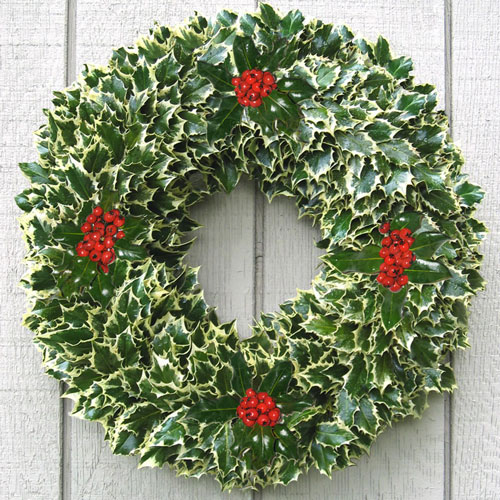
Y-not: Thanks, KT! Now I really have the Christmas spirit.
To close things up, here's another interesting tree I saw in Lexington:
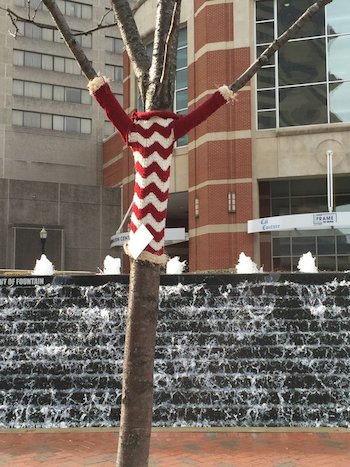
Perhaps this knitter thought she was protecting the tree from winter damage.
What's happening in YOUR gardens this week?
Link to the Archives of the Saturday Gardening Thread. **Link fixed.**
publius, Rascally Mr. Miley (w6EFb): ">> The whole world forces you and I to pay for all ..."
El Mariachi - Attorney at Law: "I worry for Trump - I appreciate how much he has t ..."
Rev. Wishbone: "Crazy Cunt Raves About Menopause And Vampires. Fi ..."
Opinion fact: "Posted by: Vengeance at January 16, 2026 06:24 PM ..."
Anonosaurus Wrecks, Like Shakespeare Except More Betterer [/s] [/i] [/u] [/b]: "Sinema was fucking multiple people on her staff an ..."
Brisco County Sr: "It's government intervening in corporatism, the ec ..."
ChristyBlinkyTheGreat: "334 When Pecker got serious I ended it toot sweet. ..."
Count de Monet: "LaWhore Vagistan, aka Kareem Khubchandani. The ..."
Steve_in_SoCal: "Yeah, I know, she's turned her life around and is ..."
Lizzy [/i]: ">>At this point, don't we just OWN Somalia? I mean ..."
bob (moron incognitus): "I'm not proposing that they be run as "non-profits ..."
Plus: More Quick Hits
Quick Hits
Mortgate Rates Fall to Lowest Level In Three Years As CNN Grieves
Trump Again Warns Walz and Frey: Start Enforcing the Law, Or Federal Troops Are Coming
For Some Reason AP and ABC "News" Cannot Even Guess At, Overdose Deaths In the US Plummeted in 2025
Thwarted True Venezuelan President Presents Her Nobel Peace Prize to Trump
As SCOTUS Debates "Trans Women" Competing in Girls Sports, the World's 671st Ranked Male Tennis Player Easily Beats the Woman Ranked #1; also, Remembering Scott Adams and Dilbert
Mid-Morning Art Thread
The Morning Report — 1/16/26
Daily Tech News 16 January 2026
Paul Anka Haiku Contest Announcement
Integrity SAT's: Entrance Exam for Paul Anka's Band
AllahPundit's Paul Anka 45's Collection
AnkaPundit: Paul Anka Takes Over the Site for a Weekend (Continues through to Monday's postings)
George Bush Slices Don Rumsfeld Like an F*ckin' Hammer
Democratic Forays into Erotica
New Shows On Gore's DNC/MTV Network
Nicknames for Potatoes, By People Who Really Hate Potatoes
Star Wars Euphemisms for Self-Abuse
Signs You're at an Iraqi "Wedding Party"
Signs Your Clown Has Gone Bad
Signs That You, Geroge Michael, Should Probably Just Give It Up
Signs of Hip-Hop Influence on John Kerry
NYT Headlines Spinning Bush's Jobs Boom
Things People Are More Likely to Say Than "Did You Hear What Al Franken Said Yesterday?"
Signs that Paul Krugman Has Lost His Frickin' Mind
All-Time Best NBA Players, According to Senator Robert Byrd
Other Bad Things About the Jews, According to the Koran
Signs That David Letterman Just Doesn't Care Anymore
Examples of Bob Kerrey's Insufferable Racial Jackassery
Signs Andy Rooney Is Going Senile
Other Judgments Dick Clarke Made About Condi Rice Based on Her Appearance
Collective Names for Groups of People
John Kerry's Other Vietnam Super-Pets
Cool Things About the XM8 Assault Rifle
Media-Approved Facts About the Democrat Spy
Changes to Make Christianity More "Inclusive"
Secret John Kerry Senatorial Accomplishments
John Edwards Campaign Excuses
John Kerry Pick-Up Lines
Changes Liberal Senator George Michell Will Make at Disney
Torments in Dog-Hell
The Ace of Spades HQ Sex-for-Money Skankathon
A D&D Guide to the Democratic Candidates
Margaret Cho: Just Not Funny
More Margaret Cho Abuse
Margaret Cho: Still Not Funny
Iraqi Prisoner Claims He Was Raped... By Woman
Wonkette Announces "Morning Zoo" Format
John Kerry's "Plan" Causes Surrender of Moqtada al-Sadr's Militia
World Muslim Leaders Apologize for Nick Berg's Beheading
Michael Moore Goes on Lunchtime Manhattan Death-Spree
Milestone: Oliver Willis Posts 400th "Fake News Article" Referencing Britney Spears
Liberal Economists Rue a "New Decade of Greed"
Artificial Insouciance: Maureen Dowd's Word Processor Revolts Against Her Numbing Imbecility
Intelligence Officials Eye Blogs for Tips
They Done Found Us Out, Cletus: Intrepid Internet Detective Figures Out Our Master Plan
Shock: Josh Marshall Almost Mentions Sarin Discovery in Iraq
Leather-Clad Biker Freaks Terrorize Australian Town
When Clinton Was President, Torture Was Cool
What Wonkette Means When She Explains What Tina Brown Means
Wonkette's Stand-Up Act
Wankette HQ Gay-Rumors Du Jour
Here's What's Bugging Me: Goose and Slider
My Own Micah Wright Style Confession of Dishonesty
Outraged "Conservatives" React to the FMA
An On-Line Impression of Dennis Miller Having Sex with a Kodiak Bear
The Story the Rightwing Media Refuses to Report!
Our Lunch with David "Glengarry Glen Ross" Mamet
The House of Love: Paul Krugman
A Michael Moore Mystery (TM)
The Dowd-O-Matic!
Liberal Consistency and Other Myths
Kepler's Laws of Liberal Media Bias
John Kerry-- The Splunge! Candidate
"Divisive" Politics & "Attacks on Patriotism" (very long)
The Donkey ("The Raven" parody)

